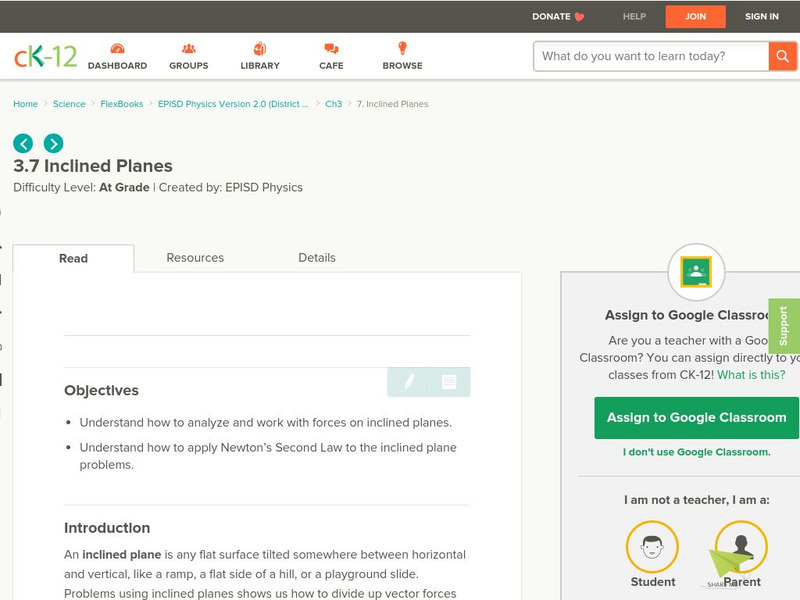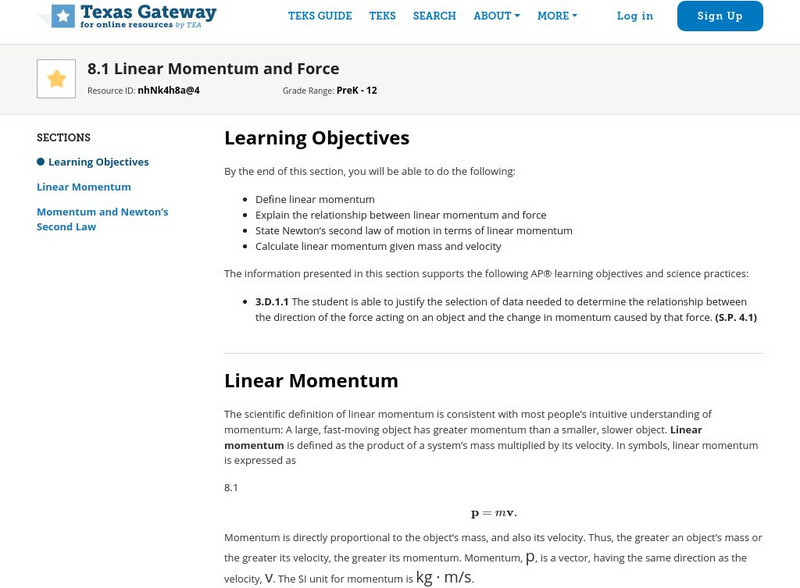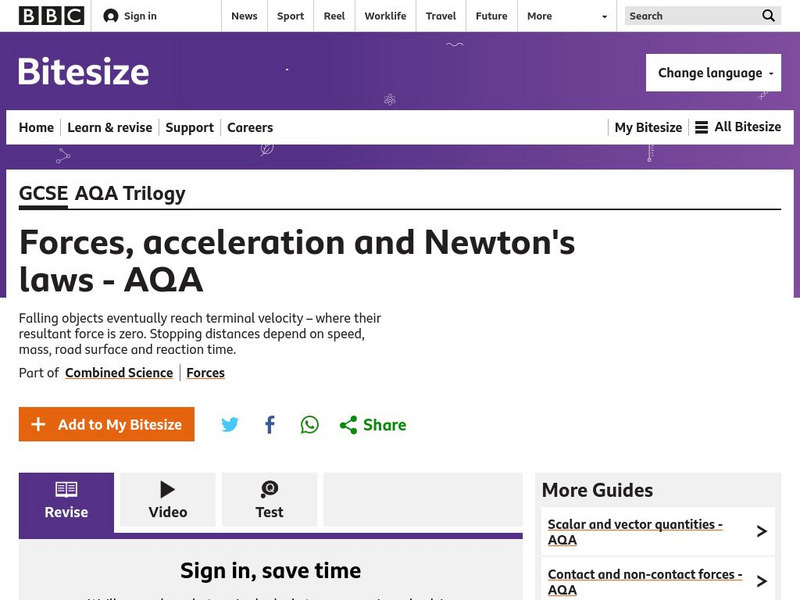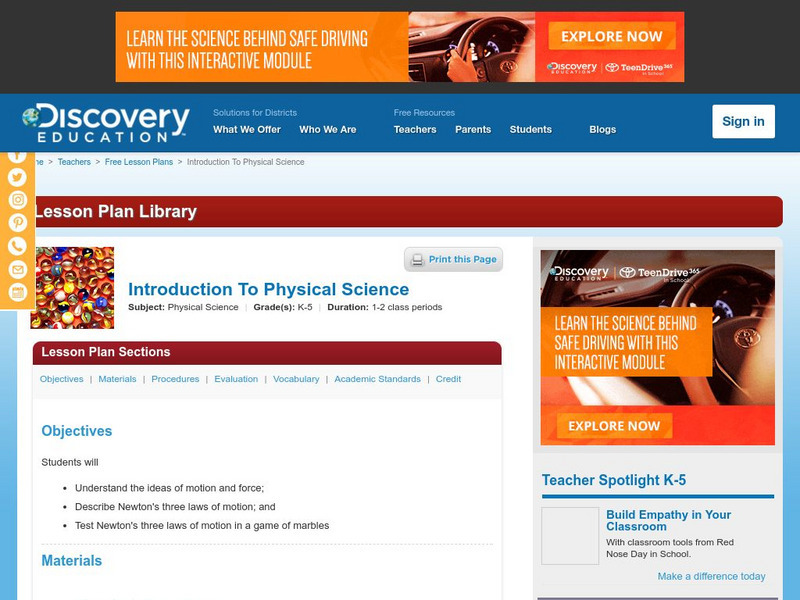Other
Easyphysics: Chapter 4 Forces
Learners investigate forces and Newton's laws. Some topics examined are mass, friction, and Newton?s laws of motion. The resource includes example problems with solutions and a chapter quiz.
Physics Classroom
The Physics Classroom: Newton's Laws: Identifying Action Reaction Force Pairs
Students are give the opportunity to practice some action-reaction pair problems. Each example is self-checking for on-the-spot reinforcement.
CK-12 Foundation
Ck 12: Episd: Inclined Planes
[Free Registration/Login may be required to access all resource tools.] Students will identify how work and force are figured out on inclined planes as well as how to apply Newton's Second Law of Motion to them.
OpenStax
Open Stax: Linear Momentum and Force: Linear Momentum
From a chapter on Linear Momentum and Collisions in a Physics textbook. This section of the chapter covers linear momentum, how momentum and force are related, how momentum fits into Newton's second law of motion, and how to calculate...
TeachEngineering
Teach Engineering: Rocket Power
By making and testing simple balloon rockets, students acquire a basic understanding of Newton's third law of motion as it applies to rockets. Using balloons, string, straws and tape, they see how rockets are propelled by expelling...
Texas Education Agency
Texas Gateway: Linear Momentum and Force
By the end of this section, you will be able to define linear momentum, explain the relationship between linear momentum and force, state Newton's second law of motion in terms of linear momentum, and calculate linear momentum given mass...
Science Struck
Science Struck: What Is Gravity and How Does It Work
A very detailed look at gravitational force and the many theories that have been put forward to try to explain it. Includes lots of illustrations.
Science and Mathematics Initiative for Learning Enhancement (SMILE)
Smile: Third Law of Motion
This Illinois Institute of Technology site provides a teacher lesson plan for an activity in which students use spring balances and carts to investigate the action-reaction relationship for any given force. Includes directions, materials...
Khan Academy
Khan Academy: What Is Newton's Second Law?
Learn about the fact that forces cause acceleration in this article about Newton's Second Law. Includes examples and worked examples of problems.
Khan Academy
Khan Academy: What Is Newton's Third Law?
This article offers a description and real-life examples of Newton's Third Law. Practice questions are included to test your knowledge!
BBC
Bbc: Gcse Bitesize: Forces, Acceleration and Newton's Laws Aqa
This lesson focuses on Newton's First Law: an object remains in the same state of motion unless a resultant force acts on it. If the resultant force on an object is zero, this means: a stationary object stays stationary; a moving object...
Open Curriculum
Open Curriculum: Analysis of Forces
This study information helps students apply Newton's third law and understand forces.
Discovery Education
Discovery Education: Introduction to Physical Science
Introduce students to the ideas of motion and force in this hands-on lesson plan.
Science Education Resource Center at Carleton College
Serc: Investigating Newton's Third Law Through Film Canister Cannons
In this physics lab (best done outside), students will explore Newton's Third Law - 'For every action there is an equal and opposite reaction'. Students will fill empty 35-mm film canisters with water and part of an Alka-Seltzer tablet,...
TeachEngineering
Teach Engineering: Flying With Style
As students begin to understand the physics behind thrust, drag, and gravity and how these relate these to Newton's three laws of motion, groups assemble and launch the rockets that they designed in the associated lesson.
University of Colorado
University of Colorado: Ph Et Interactive Simulations: Gravity Force Lab
An interactive simulation that teaches about gravitational force, Newton's Third Law, and force pairs by varying properties affect the gravitational force exerted between two objects. This simulation can either be downloaded or played...
Other
Bscs: Forces and Motion Content Background Document
In this document, we will try to answer a fundamental question of physical science, "Why do things start to move, slow down, speed up, stop moving or change direction?" In answering these core questions we can develop concepts that can...
Sophia Learning
Sophia: Momentum & Newton's Second Law of Motion
This lesson explains how momentum is related to Newton's second law of motion.
Science Education Resource Center at Carleton College
Serc: Newton's 2nd Law: Inquiry Approach
In this activity, students test Isaac Newton's ideas on the nature of motion, in particular his 2nd Law. The emphasis is on the process of science, investigation, and experimentation, not the results. Students must come up with their own...
CK-12 Foundation
Ck 12: Physics Simulation: First Law Simulation
[Free Registration/Login Required] In this simulation, students investigate the question of whether force is required to keep a sled moving on ice.
The History Cat
The History Cat: Isaac Newton
Profile of Isaac Newton, with a description of his scientific theories, the impact he had on the world of science in his day, and the influence his ideas still have in the world today.
Cosmo Learning
Cosmo Learning: Newton's Laws
Do you need to review any of Newton's three laws? This website contains a video collection on Newton's Law from a physics course at East Los Angeles College. In twelve lectures, each law is explained with examples. Also discussed is...
Georgia Department of Education
Ga Virtual Learning: A Brief History of Astronomy
In this interactive module students will explore what different ancient cultures believe was an explanation of the stars and planets. They will look at how the work of Nicolas Copernicus revolutionize the world of astronomy and learn how...
Science Education Resource Center at Carleton College
Serc: Inertia: An Object in Motion Will Tend to Stay in Motion
This activity is a take off of Galileo's experiment with the inclined planes to show that an object in motion would stay in a straight line motion if no outside forces acted were acting on it. In this version, students will roll a ball...


















